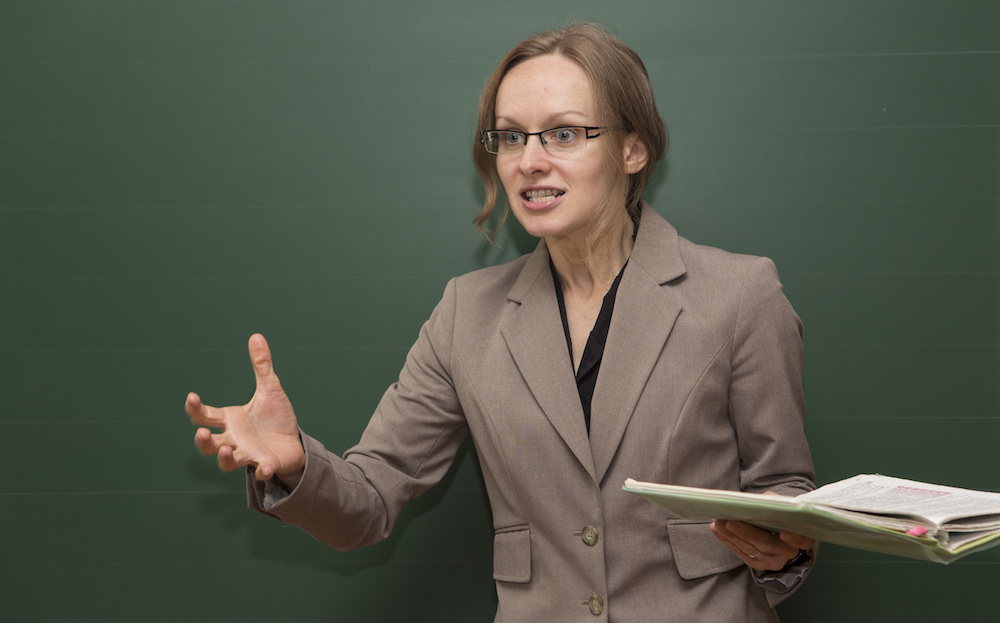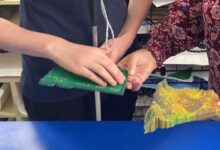How to teach and engage Aboriginal students

Teaching Aboriginal students requires sensitivity for their special needs and knowledge about Aboriginal cultural protocols. Successful programs relate content to real life and work around Aboriginal parents’ limitations.
Tips for teaching Aboriginal students
Many non-Aboriginal teachers do not have a lot of experience teaching and engaging Aboriginal children. To reach them and get them interested in learning, teachers must sometimes leave behind the textbook solutions they studied.
Know cultural behaviours
Aboriginal students can avoid direct eye contact to an adult as it is considered rude in Aboriginal culture. When teachers misdiagnose Aboriginal students’ classroom behaviour we can speak of ‘soft racism’.
Aboriginal children are also less likely to answer questions in the classroom because traditionally, Aboriginal culture has been passed on through the telling of stories; it’s not about questions and answers [11].
“I realise that many children might know the answer, but aren’t comfortable speaking up. Instead, I try to incorporate more ‘hands on’ learning and a greater variety of practical experiences into our lessons,” explains Aboriginal teacher Matthew Pinchbeck of NSW [11].
You see them run wild but then you realise they have no role models where they are from. They arrive here hungry, sick and infested with head lice… Some of it is horrific.—Tekoa Tafea, teacher [12]
Don’t expect them to underperform
If Aboriginal student numbers are low, teachers might ignore Aboriginal students, expect them to deliver low results or victimise them.
“I dreamt big,” says Aboriginal gold medal winner and politician Nova Peris. “Most people would have looked at an Aboriginal girl from the Territory, with its statistics of alcohol abuse, youth suicide, domestic violence, imprisonment rates and substandard education, and point to every reason why I should not succeed. But I was determined to be successful.” [7]
Sky News international editor and Wiradjuri man, Stan Grant, remembers: “Aboriginal kids like me were too often denied opportunity, ignored or held captive to the low expectations of others. Indeed at age 14 I, along with my black cousins and mates, was encouraged to leave school, our principal said there was no meaningful place for us.” [18]
Instead, have high expectations. “I want them to reach for the stars,” says principal Paul Eaglestone from Looma Remote Community School in WA. “We’re all about student gain. I prefer high targets, even if sometimes students do well but don’t quite get there.” [21] The success of his school proves him right.
“I give the students examples,” explains Len Yarran from Balga Senior High School (WA). “I tell them there are people who came from alcoholic households, suicides in their family, backgrounds where there was no hope, and they have changed their lives. Some of them are in really influential positions.” [21]
A good teacher views the kids as people and not as artifacts or objects of cultural disposition.—Jean Illingworth, teacher [12]
High expectations = high outcomes
Children of Asian background are often perceived to be “smarter” than their other classmates. Researchers found that they enter schools with no significant academic advantage, but outperformed their non-Asian classmates significantly in Grade 5 [17].
They found Asian families (“Tiger Mums”) were more likely to set higher expectations for their children. Greater effort from the students, and not advantages, contributed to academic success.
Similarly, if teachers set high expectations for Aboriginal students they can motivate them to succeed.
“Classmates who were straight-A students were never told they couldn’t do medicine. I was a straight-A student but I was black,” recalls Dr Kris Rallah-Baker, Australia’s first eye doctor. A careers adviser told a young Kris that he would not get into medicine [19].
Relate examples to their environment and community
Teaching Aboriginal students needs to convey a “relatedness” [3], which is a key feature of Aboriginal world views. It stems from the connectedness to every living thing, which is the foundation of Aboriginal tradition, culture and spirituality.
When your lessons are relevant to students and applicable to everyday activities results can improve significantly. This sense of relatedness helps them answer the question “Who am I” and “Where do I fit in”, rather than “What do I want to be?” [10].
Aboriginal children look at this macro view of the world before narrowing it down to the micro [10]. Students would look around and notice who is not there rather than who is there.
The Teaching Indigenous Maths Education (TIME) program at Queensland University of Technology related mathematics classes to everyday tasks such as shopping and sports. Students were much more engaged, and some gained A-level results for the first time while none received an E-level [9].
Will Lutwyche taught for 2 years in remote Tennant Creek, NT. He learned that in order to engage his students he had to bring local stories into the classroom.
“In the end their stories really drove the history unit, along with the stories of community members. It was more relevant and integral to their lives, and their families and the town of Tennant Creek. They engaged well with it and started to reflect deeply and use critical thinking, which is not always easy to do without relevant content.” [1]
Help them fake power to become powerful
In the TED talk below, social scientist Amy Cuddy reveals typical body postures of people who feel inferior and the messages this sends to their brain.
By faking a posture of power, even if for just two minutes, the brain receives signals of more power which reduces cortisol (the stress hormone) and increases testosterone (the hormone of power).
Why not invite Aboriginal students to fake these postures until they, like a student Amy coached, become more self-confident? (Video runs for approx. 20 minutes)
Stolen Generations: wounds & victims
All the horrific Aboriginal history, for example the pain of the Stolen Generations, should not allow students an excuse to behave badly. To become part of Australian society they have to stop feeling like victims [12].
Some Aboriginal parents don’t want the Stolen Generations topic taught at school at all as they fear it can open wounds for the children as their aunties, uncles, mothers, fathers or grandparents might be affected [15]. Most kids already know through their families.
Effects of the Stolen Generations still have implications on each student’s life. When teaching about this chapter, teachers need to protect students’ privacy and not expect them to talk about their personal stories [13].
TipA valuable resource is Calmer Classrooms – A guide to working with traumatised children, published by the Queensland government’s Department of Education and Training.
Be aware of a greater sense of autonomy
Aboriginal children have been raised to be autonomous individuals with a right to express their needs and opinions and have them taken seriously. But a strong character can get them into trouble in a classroom [10].
It was education, plain and simple, that changed the way I look at the world, it probably changed the way the world looks at me.—Vickie Roach, Aboriginal graduate, Institute of Koorie Education, Deakin University, Melbourne [4]
Include community spirit
Aboriginal students are more used to working for the collective good rather than focusing on individual achievement. It is foreign for them to be tested as ‘individuals’ for their knowledge, when their usual context is seeing what the group can achieve collectively [10].
Looma Remote Community School, about 120 km south-east of Derby, WA, uses a high level of community involvement and togetherness as a crucial factor to its success in education. Every morning, students, and often parents, play ‘heads and tails’ in morning assembly. Parents and carers often join sack races and tugs of war at sports carnivals and eat lunch with children. [21]
Remember English is a foreign language
For many Aboriginal children English is their second, third or fourth language. Teachers should explain things in more than one way and more than once to enable Aboriginal students to understand and learn. In Aboriginal culture knowledge was passed on through repetitive story-telling.
If possible, Aboriginal children should be taught in their first language. “Learning to read and write requires the brain to be neurologically developmentally primed,” explains speech pathologist Mary-Ruth Mendel [2]. “Children’s brains need to be stimulated in the first language that they speak.”
Bilingual programs and children’s textbooks help Aboriginal children to live in two worlds and improve literacy rates.
Cultural knowledge a must for language teachers
Here are some insights from Jasmin Martin, an Australian teacher living in Germany [16]:
“I teach English here to the locals, and I see that the same approach that you described has to be taken with each student of a second or third or fourth language.
“Even Germans are a little apprehensive of English and the domination of English within their own language and dialects. I could not imagine trying to teach English to Germans, without knowing any German or having any sense for the way they think or live.
“Likewise, I could not imagine teaching English to Aboriginal communities in Australia, without knowing anything about their culture, language and what makes them tick, even if I have lived in Australia all my life and also lived up north in Darwin for many years.”
Promote Aboriginality
For Aboriginal students to have a full and productive life, they need to receive an education that enhances and promotes their Aboriginality. Teachers can encourage cultural pride through programs such as music and dance.
Address racism and use an open dialogue in a positive way: “This is the past; however, you are the people that can change that, this is how things have been done in the past, but you can make Australia a better place.” [1]
Give students more chances
Many behavioural problems can be managed by taking the time to listen and giving students a “second, third and forth” chance [12].
Consider broken homes
Many Aboriginal students come from dysfunctional families where they need to dodge domestic violence or alcohol abuse. Many have emotional problems that materialise when they reach their mid-teens. Providing pastoral care lets them develop trust and feel safe and valued [12].
In remote communities many Aboriginal kids are not taught values at home. If teachers spend half an hour teaching basic norms they get much more control over their students [12].
There is a lack of positive role models for Aboriginal students, especially boys who have no father figures in their lives through death or separation.[21] They need basic strategies for their immediate needs, for example extra attention, food or a talk about what happened the previous night at home.
We have waves of suspensions and expulsions of Aboriginal kids who cannot cope because there is so much violence in their bodies. We need to put healing into the curriculum.—Prof Judy Atkinson, head of Gnibi College of Indigenous Australian Peoples [12]
Offer homework classes
Students (especially of remote communities) don’t have computers at home, sometimes not even a desk.
Education NRL-style: One metre at a time
Cherbourg State School in Queensland has implemented a popular reading program [6] borrowing some ideas from National Rugby League (NRL) rules.
Each classroom is divided into 4 NRL teams. Students gain ‘metres’ on a virtual field for their attendance, work ethic and behaviour.
If a team has 100% attendance for any given day it automatically makes 10 metres.
Further metres can be made if the children read magazines or do puzzles of a night at home.
There are also physical activities played outside for extra metres.
[The program] is about boosting numeracy, literacy, behaviour and the idea of team building to reach and end goal.—Steve Belsham, Australian Rugby League development officer [6]
How to create a culturally responsive classroom
“It’s very easy to say I want to have a culturally responsive classroom but to know what that looks like was a bit more difficult than I thought,” admits Will Lutwyche who taught Aboriginal kids for 2 years in remote Tennant Creek, NT. [1]
He found the following components to work well:
- Build trust. “You need to get to know the kids really well before you can [teach],” says Will. “There needs to be mutual trust to establish your legitimacy. They can’t gauge your authenticity straight off.”
- Acknowledgement of Country. Before a class, acknowledge the traditional custodians of the land where you teach.
- Embrace diversity. Honour students’ diversity within Aboriginal culture by letting them mark their nation, language group or moiety on a Aboriginal Australia wall map. Note that withing the same community there might also be cultural ceremonial differences, kinship differences and totem differences. What works in one community most likely won’t work in another.
- Liaise with Elders. Run your curriculum ideas by Elders first. They can also introduce you to contacts in the community and people who can speak to the class.
- Invite community members. Get community members into the classroom to share their stories and have a yarning circle.
- Explore family trees. Will found it effective to explore children’s family trees.
- Let students teach. Have students run a lesson, which is often something they’ve never experienced before and fosters their self-esteem.
- Use local resources. To support community context, use local resources that align with the curriculum. Will found written resources relevant to Tennant Creek buried deeply in books, and a DVD about the Coniston Massacre which occurred just south of Tennant Creek.
- Promote calmness. Will found it very helpful to introduce routines, such as doing vocabulary at the beginning of each lesson, and then quiet reading or writing, or a bit of mindfulness practice to calm students down.
- Don’t yell. “Once kids realise I’m not going to get angry with them, they settle down,” says Will.
Students in only one class were affiliated with 17 different culture/language group[s] – though most of them had numerous responsibilities and affiliations through different family lines.—Will Lutwyche, teacher [1]
Prepare students for walking in two worlds
In some parts of Australia Aboriginal people have “a huge hesitation” about the embrace of Western education, according to Aboriginal elder Noel Pearson [7]. Many Aboriginal people are afraid of losing their children to a bigger world, and their children losing their identity and culture.
Educational systems designed to Western standards give Aboriginal people little to motivate them to have faith—on the contrary, many feel disrespected and marginalised. Academics think of Aboriginal people as “guests in the dominant educational domain”. [21] This ‘guest paradigm’ defines the relationship that Aboriginal people have with ‘Eurocentric’ education systems.
Teaching both worlds might be the answer to these problems.
Aboriginal leaders try to foster “a [cultural] centre of gravity” in their children so that they are able to “operate in two worlds” [7]. Only when children accommodated both western and traditional Aboriginal culture would they be able to build their socio-economic strengths and maintain, revive and re-double the strength of their cultural determination, Mr Pearson said.
The Boonderu Music Academy in Roebourne, Western Australia, recognises that Aboriginal culture is based on song and story telling and encourages kids to enjoy school through the use of music first and worry about grades later. This approach entices students to go to school, validated by an attendance rate of 80%. [20]
“My generation have learned now, that to live in this society, we must walk in two worlds,” says Kendall Smith, one of the mentors and music teachers at the academy. “We must learn to adapt to be white man world, in that way, but then as soon as we get home, doing what our old people have done for 45,000 years—going out bush, hunting, singing law and ceremony songs… that is the key to the survival of our Aboriginal people.
“While everyone else was learning how to drink and do drugs, we sort of kept to ourselves and played music. We were trying to find another way,” Smith said. [20]
Black science has observation and experience, white science has measurements and experiments. If we put the two of them together we’d get a much deeper science.—Frances Bodkin, Dharawal Elder, NSW [8]
Better marks at a community-owned school
The Aboriginal and Islander Independent Community School, also known as “Murri School” after the name of Aboriginal people of Queensland, operates since 25 years in Brisbane [5].
The school is community-owned, develops its own policies and decides on teaching directions.
Unlike most mainstream independent schools the Murri School does not charge parents expensive fees. Since many Aboriginal parents are unemployed the school only charges a small fee for food. It provides students with three meals a day and transport to and from school.
Because of this financial and practical help the Murri School does not have any issues with students not attending school, unlike many mainstream schools with Aboriginal students.
Students are thriving and score well in the National Assessment Program – Literacy and Numeracy (NAPLAN) exam.
Our children achieve higher in the tests after being schooled in our system then they do after being schooled through Education Queensland.—Tiga Bayles, board president, Aboriginal and Islander Independent Community School Brisbane [5]
Source: www.creativespirits.info







